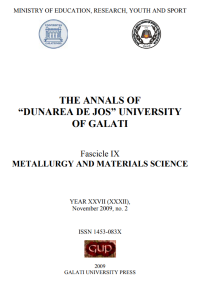Influence of pH Galvanic Baths on the Nickel Deposits
Abstract
The influence of pH on cathodic and anodic current efficiency, surface quality and morphology of nickel deposit in the electrolyte solutions of the Watts bath type was investigated. Cathodic current efficiency of nickel deposit is maximum for electrolytic bath whose pH value is about 4 and decreases for an electrolytic bath with a higher pH. The deposited thickness is a significant parameter because the thickness determining may establish if the deposition corresponds to the destination application deposition or not; and the measurements were made by non-destructive physical methods. The properties of nickel deposits, brightness and hardness are influenced by the pH of the bath electrolyte. The surface morphology of nickel deposit was analyzed by scanning electronic microscopy (SEM). The results showed that the structure of nickel deposits is influenced by pH of the bath. The pH increasing causes structural changes on the deposits in fine to coarse, while the electrodeposited nickel at pH 6.21 has a compact morphology with many cracks.
Downloads
References
[2]. Marinescu A., Andonianţ Gh., Bay E. - Tehnologii electrochimice şi chimice de protecţie a materialelor metalice, Editura Tehnică, Bucureşti, 1984.
[3]. Oniciu, L., Grűnwald, E. - Galvanotehnica, Editura Ştiinţifică şi Enciclopedică, Bucureşti, 1980.
[4]. di Bari G. - Modern Electroplating, Fourth Edition, Edited by Mordechay Schlesinger and Milan Paunovic © 2000 John Wiley & Sons. Inc, New York, 2000.
[5]. Deligianni H., L. Romankiw T. - In situ surface pH measurement during electrolysis using a rotating pH electrode, IBM J. Res. Develop., 37, 2, 1993.
[6]. Ji J., Cooper W.C., Dreisinger D.B., Peters E. - Surface pH measurements during nickel electrodeposition. Journal of Applied Electrochemistry (1995), 25 (7), 642-650.
[7]. Vasilache V., M Poroch – Seriţan M., Gutt Gh. - Contributions on elaboration of a material balance, an energetic balance and an optimization way for nickel cover process, Conferinţa Ştiinţifică UgalMat 2007, vol. II, 383-388.
[8]. di Bari G. A. - International Nickel Inc., Saddle Brook, N.J.; www.inco.com, electroplating solutions, Nickel Plating, Metal Finishing, Volume 98, Issue 1, Ianuary 2000, p. 270-288, wwwscience direct.com.
[9]. Rose I., Whittington C. - Nickel Plating Handbook, OMG Finland Oy, 2002, nickel.sales@omgi.com, www.omgi.com.
[10]. ***, http://ro.wikipedia.org/wiki/Culoare.
[11]. Doi T., MizumotoK., Tanaka S., Yamashita T. - Bright Nickel Plating from Nickel Citrate Electroplating Baths, Metal Finishing, 2004, 26-35.
[12]. Doi T., MizumotoK., Tanaka S., Yamashita T. - Effect of Bath pH on Nickel Citrate Electroplating Bath, Metal Finishing, 2004, 104-111.
[13]. Firoiu C. - Tehnologia proceselor electrochimice, Editura Didactică şi Pedagogică, Bucureşti, 1983.
[14]. LI Chao-qun, LI Xin-hai, WANG Zhi-xin, GUO Hua-jun - Nickel electrodeposition from novel citrate bath, Trans. Nonferrous Met. SOC. China, 17 (2007) 1300-1 306, www.csu.edu.cnlysxb.



